Yamaha MCR-042 User Manual
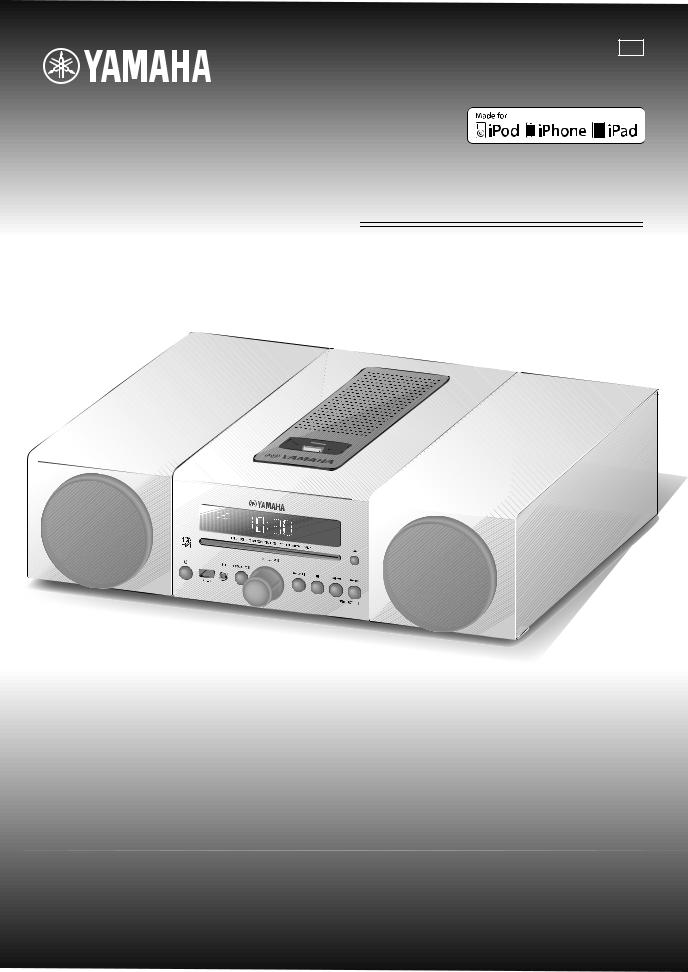
G
MICRO COMPONENT SYSTEM
MICRO-CHAINE
MCR-042
2 |
7 |
M a y |
|
OWNER’S MANUAL MODE D’EMPLOI BEDIENUNGSANLEITUNG BRUKSANVISNING MANUALE DI ISTRUZIONI MANUAL DE INSTRUCCIONES GEBRUIKSAANWIJZING
ИНСТРУКЦИЯ ПО ЭКСПЛУАТАЦИИ
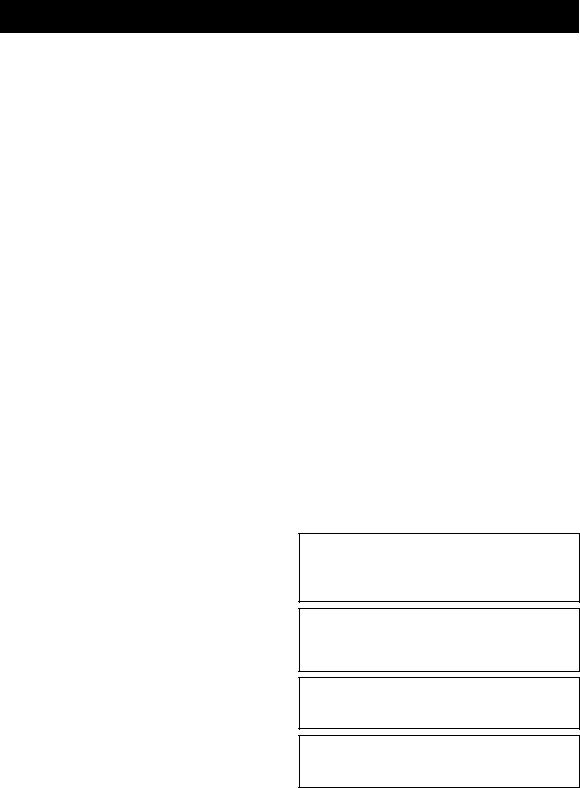
CAUTION: READ THIS BEFORE OPERATING YOUR UNIT.
1To assure the finest performance, please read this manual carefully. Keep it in a safe place for future reference.
2Install this unit in a well ventilated, cool, dry, clean place - away from direct sunlight, heat sources, vibration, dust, moisture and cold. For proper ventilation, allow the following minimum clearances.
Top: 15 cm (6 in) Rear: 10 cm (4 in) Sides: 10 cm (4 in)
3Locate this unit away from other electrical appliances, motors, or transformers to avoid humming sounds.
4Do not expose this unit to sudden temperature changes from cold to hot, and do not locate this unit in an environment with high humidity (i.e. a room with a humidifier) to prevent condensation inside this unit, which may cause an electrical shock, fire, damage to this unit, and/or personal injury.
5Avoid installing this unit where foreign object may fall onto this unit and/or this unit may be exposed to liquid dripping or splashing. On the top of this unit, do not place:
–Other components, as they may cause damage and/or discoloration on the surface of this unit.
–Burning objects (i.e. candles), as they may cause fire, damage to this unit, and/or personal injury.
–Containers with liquid in them, as they may fall and liquid may cause electrical shock to the user and/or damage to this unit.
6Do not cover this unit with a newspaper, tablecloth, curtain, etc. in order not to obstruct heat radiation. If the temperature inside this unit rises, it may cause fire, damage to this unit, and/or personal injury.
7Do not plug in this unit to a wall outlet until all connections are complete.
8Do not operate this unit upside-down. It may overheat, possibly causing damage.
9Do not use force on switches, knobs and/or cords.
10When disconnecting the power cable from the wall outlet, grasp the plug; do not pull the cable.
11Do not clean this unit with chemical solvents; this might damage the finish. Use a clean, dry cloth.
12Only voltage specified on this unit must be used. Using this unit with a higher voltage than specified is dangerous and may cause fire, damage to this unit, and/or personal injury. Yamaha will not be held responsible for any damage resulting from use of this unit with a voltage other than specified.
13To prevent damage by lightning, keep the power cable disconnected from a wall outlet or this unit during a lightning storm.
14Do not attempt to modify or fix this unit. Contact qualified Yamaha service personnel when any service is needed. The cabinet should never be opened for any reasons.
15When not planning to use this unit for long periods of time (i.e. vacation), disconnect the AC power plug from the wall outlet.
16Be sure to read the “TROUBLESHOOTING” section on common operating errors before concluding that this unit is faulty.
17Before moving this unit, press  to set the system to off, and disconnect the AC power plug from the wall outlet.
to set the system to off, and disconnect the AC power plug from the wall outlet.
18Condensation will form when the surrounding temperature changes suddenly. Disconnect the power cable from the outlet, then leave this unit alone.
19When using this unit for a long time, this unit may become warm. Turn the system off, then leave this unit alone for cooling.
20Install this unit near the wall outlet and where the AC power plug can be reached easily.
21The batteries shall not be exposed to excessive heat such as sunshine, fire or the like. When you dispose of batteries, follow your regional regulations.
–Keep the batteries in a location out of reach of children. Batteries can be dangerous if a child were to put in his or her mouth.
–If the batteries grow old, the effective operation range of the remote control decreases considerably. If this happens, replace the batteries with new one as soon as possible.
–Do not use old batteries together with new ones.
–Do not use different types of batteries (such as alkaline and manganese batteries) together. Read the packaging carefully as these different types of batteries may have the same shape and color.
–Exhausted batteries may leak. If the batteries have leaked, dispose of them immediately. Avoid touching the leaked material or letting it come into contact with clothing, etc. Clean the battery compartment thoroughly before installing new batteries.
–If you plan not to use the unit for a long period of time, remove the batteries from the unit. Otherwise, the batteries will wear out, possibly resulting in a leakage of battery liquid that may damage the unit.
–Do not throw away batteries with general house waste. Dispose of them correctly in accordance with your local regulations.
22Excessive sound pressure from earphones and headphones can cause hearing loss.
This unit is not disconnected from the AC power source as long as it is connected to the wall outlet, even if this unit itself is turned off by  . In this state, this unit is designed to consume a very small quantity of power.
. In this state, this unit is designed to consume a very small quantity of power.
WARNING
TO REDUCE THE RISK OF FIRE OR ELECTRIC SHOCK, DO NOT EXPOSE THIS UNIT TO RAIN OR MOISTURE.
CAUTION
Danger of explosion if battery is incorrectly replaced. Replace only with the same or equivalent type.
There is a chance that placing this unit too close to a CRTbased (Braun tube) TV set might impair picture color. Should this happen, move this unit away from the TV set.
LASER |
|
Type |
Semiconductor laser GaAS/GaAlAs |
Wave length |
790 nm |
Output Power |
7 mW |
|
|
i En
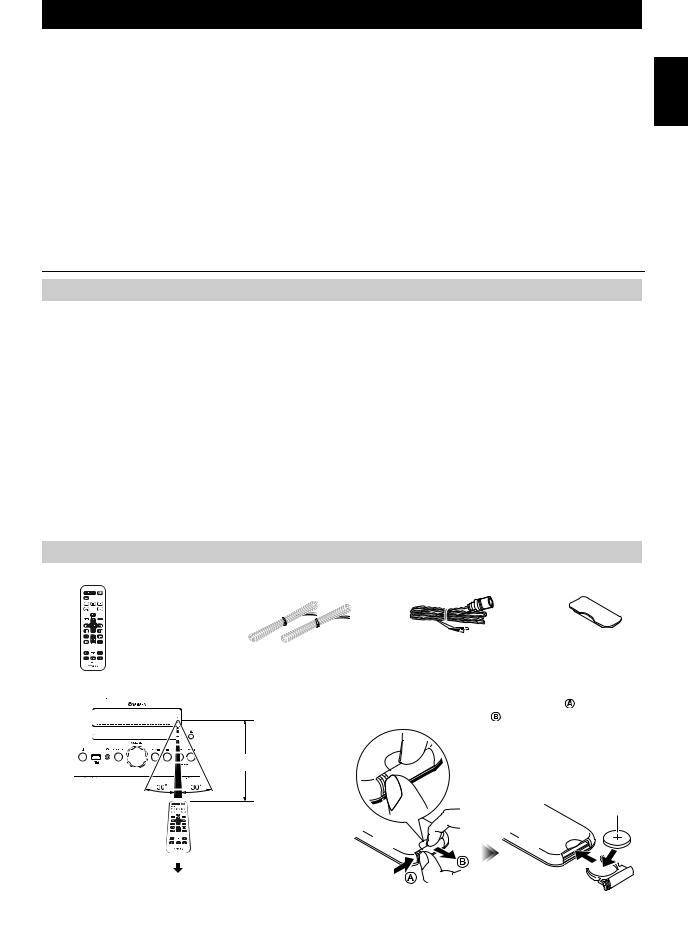
CONTENTS
CONNECTIONS ........................................................ |
2 |
LISTENING TO FM STATIONS .............................. |
11 |
Connecting the speakers and antenna .......................... |
2 |
Selecting an FM station................................................ |
11 |
Connecting the power cable........................................... |
2 |
Presetting FM stations (remote control only) ............... |
12 |
Other connections.......................................................... |
3 |
Selecting preset FM stations........................................ |
13 |
NAMES OF PARTS AND THEIR FUNCTIONS ........ |
4 |
Top panel/Front panel.................................................... |
4 |
Front panel display......................................................... |
4 |
Remote control............................................................... |
5 |
ADJUSTING THE CLOCK (OPTION MENU) ........... |
6 |
LISTENING TO YOUR iPod...................................... |
7 |
Playing music from your iPod......................................... |
7 |
Using repeat/shuffle playback (remote control only) ...... |
8 |
LISTENING TO CD AND USB DEVICES ................. |
9 |
Listening to a CD............................................................ |
9 |
Listening to a USB device ............................................ |
10 |
Using repeat/shuffle playback (remote control only) .... |
10 |
LISTENING TO EXTERNAL SOURCES ................ |
14 |
USEFUL FUNCTIONS ............................................ |
15 |
Using the Option menu ................................................ |
15 |
Using the sleep timer ................................................... |
15 |
Using the alarm function .............................................. |
16 |
Using “DTA Controller” to set the alarm ....................... |
16 |
Setting the alarm .......................................................... |
17 |
Operations while the alarm sound is playing................ |
18 |
TROUBLESHOOTING ............................................ |
19 |
NOTES ON DISCS AND USB DEVICES................ |
22 |
SPECIFICATIONS................................................... |
23 |
Features
•Play back music from external devices such as your iPod/iPhone/iPad, audio/data CDs, USB devices, or external devices via the AUX jack, and listen to the FM.
•Use your favorite music or a beep tone as an alarm. When the set time arrives, the music you select is played at the volume that you specify, giving you the ideal start to your day (IntelliAlarm function).
•You can take advantage of more sophisticated alarm functionality by using the free “DTA Controller” application for the iPod touch/iPhone/iPad ( P. 16).
•You can easily store and recall 30 of your favorite FM stations.
•Bass, middle, and treble can be adjusted to your taste.
About this manual
•References to the iPod appearing in this manual also include the iPhone.
•If an operation can be performed using either the buttons on the unit itself or from the remote control, the explanation will focus on operation using the remote control.
• indicates precautions for use of the unit and its feature limitations.
indicates precautions for use of the unit and its feature limitations.
• indicates supplementary explanations for better use.
indicates supplementary explanations for better use.
Supplied accessories
Remote control |
Speaker cable |
FM antenna |
Dock cover |
(uses a CR2032 type |
(1.5 m (4.9') x 2) |
|
|
Lithium battery) |
|
|
|
English
How to use the remote control |
Replacing the battery in the remote control |
|
While pushing the release tab in direction , slide out the |
|
battery holder in direction . |
Within 6 m (20')
CR2032 type
Lithium battery
 Battery insulation sheet:
Battery insulation sheet:
Remove before using.
1 En
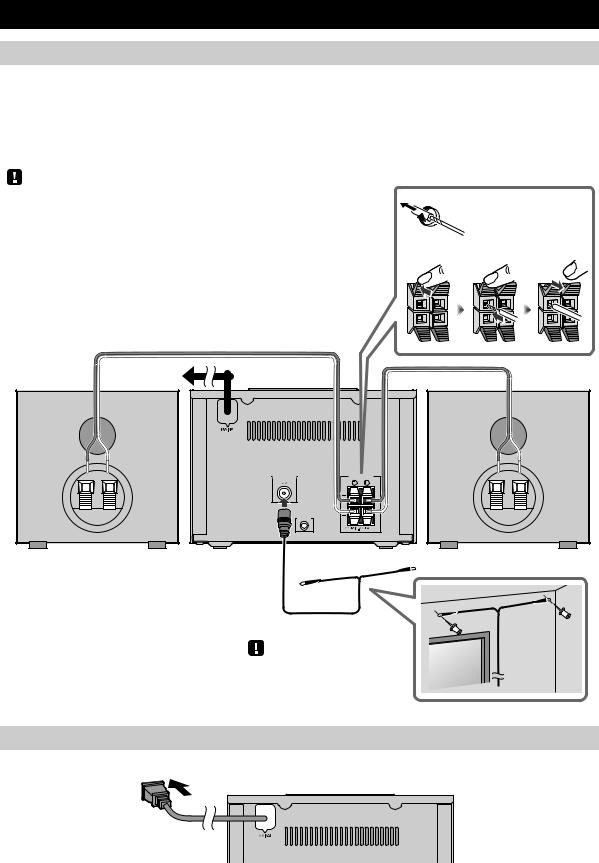
CONNECTIONS
Connecting the speakers and antenna
Connect the speakers and antenna.
If you use a commercially available outdoor antenna instead of the supplied antenna, reception may be better.
If FM reception is poor, try changing the height or direction or placement of the antenna to find a location that has better reception.
Do not connect this unit’s power cable until you’ve finished connecting all cables.
Speakers
•You must peel off the insulation (covering) from the tip of the speaker cable to expose the conductor.
•Check the connections; make sure that left and right (L, R) and polarity (red: +, black: –) are connected correctly. If connections are incorrect, the sound will be unnatural and the low frequencies may be insufficient. There might not be any sound at all if connections are incorrect.
•Take care that the conductors of the speaker cable do not touch each other, and that the conductors do not touch any other metal part. Such conditions can damage this unit or the speakers.
•Use only the supplied speakers. Using other speakers may result in unnatural sound.
•If you’re using this unit nearby a CRT display and you notice distorted color or noise in the display, move the speakers farther away from the display.
To the AC wall outlet
ANTENNA |
SPEAKERS |
FM |
|
|
AUX IN |
Twist the bare wires tightly so the individual  strands are not splayed.
strands are not splayed.
FM antenna
Be sure to stretch out the antenna.
Connecting the power cable
When you’ve completed all connections, connect this unit’s power cable to an AC outlet.
Rear panel
2 En

CONNECTIONS
Other connections
iPod
Connect your iPod to the iPod dock on the top panel. For details on compatible iPod models, refer to “SPECIFICATIONS” (P. 23).
|
|
• Be sure to use a dock adaptor that is compatible with your iPod. If you do not use the adaptor or the |
Dock |
|
adaptor is not compatible, the connection could be loose or poor, which could cause damage to the |
adaptor |
iPod dock |
connector. For details on dock adaptor information, please visit Apple’s official website. |
|
|
• If an iPod in a protective case is forcibly connected, the connector may be damaged. Remove the |
|
|
protective case before connection. |
• When the iPod is not in use, install the dock cover to protect the connector.
•Your iPod will be recharged while it is connected to the dock. However if USB is selected as the audio source, the iPod will not be recharged.
• Your iPod can also play back music and charge while connected to the USB port. To do this, select USB as the audio source ( P. 10).
• You can remove the iPod during playback.
iPad
Connect your iPad to the front panel USB port. For details on compatible iPad models, refer to “SPECIFICATIONS” (P. 23).
Make sure to use a Dock Connector to USB Cable that is supplied with your iPad.
• When you turn the system on and set the audio source to USB, the iPad connected to this unit will be recharged.
• You can remove the iPad during playback.
English
USB device
Connect your USB device to the USB port on the front panel. For details on playable files, refer to “NOTES ON DISCS AND USB DEVICES” (P. 22).
Stop playback before disconnecting the USB device.
When you turn on the system and set the audio source to USB, the USB device connected to this unit will be recharged.
External devices
Using a commercially available 3.5 mm mini-plug cable, connect your external device to the AUX jack on the rear panel of this unit.
Rear panel
AUX IN |
3 En

NAMES OF PARTS AND THEIR FUNCTIONS
Top panel/Front panel
1
2
3



 k
k
4 |
5 6 7 |
8 |
9 |
j |
aiPod dock
Connect your iPod here ( P. 3, 6, 7).
Be sure to use a dock adaptor that is compatible with your iPod ( P. 3).
bFront panel display
The clock and other information is displayed here.
cDisc slot
Insert a CD here ( P. 9).
d (Power)
(Power)
Press to turn the system on/off.
eUSB port
Connect your USB device/iPod/iPhone/iPad here ( P. 3, 10).
f (Headphone jack)
Connect headphones here.
gSOURCE
Switch the audio source to be played.
Pressing this repeatedly will change the selection in the following order.
CD  iPod
iPod  USB
USB  FM
FM  AUX
AUX  back to CD
back to CD
hVOLUME knob
Adjust the volume.
iAudio control buttons
Use these to operate the iPod/CD/USB device.
 : Play/Pause
: Play/Pause
 : Stop
: Stop
 /
/ : Skip, Search backward/forward (press and hold
: Skip, Search backward/forward (press and hold
down)
jPRESET  /
/ 
Use these buttons to select a radio station (preset) that you’ve stored ( P. 13).
k (Eject button)
Eject the CD (cannot be operated while the option menu ( P. 15) is displayed).
Front panel display
1 |
2 |
3 |
4 |























































 ~ ~ ~ ~ ~ ~
~ ~ ~ ~ ~ ~ 























































 ~ ~ ~ ~ ~ ~
~ ~ ~ ~ ~ ~
7 6 5
aAlarm time
This indicates the alarm time ( P. 17).
bRepeat/shuffle indicator
Displays the playback mode ( P. 8, 10).
cMulti-function indicator
Displays various information, including the clock time, information about the currently-playing track, and the frequency of the radio station.
dRemote control signal receiver
Make sure that this sensor is not obstructed ( P. 1).
eSleep indicator
Turns on if the sleep timer has been set ( P. 15).
fAlarm indicator
Turns on if the alarm has been set ( P. 17).
gWeekly alarm indicator
Shows alarm information specified using the free “DTA Controller” application for the iPod touch/iPhone/iPad ( P. 16).
4 En

Remote control
1
2
3
4
5
6
7



8
9
j
k
l


 m
m



iPod control buttons
NAMES OF PARTS AND THEIR FUNCTIONS
|
aRemote control signal transmitter |
|||
|
b |
(Power) |
||
|
|
Press to turn the system on/off. |
||
|
cSNOOZE/SLEEP |
|||
|
|
Set the sleep timer or switch the alarm to snooze mode |
||
|
|
( P. 15, 18). |
||
|
dALARM |
|||
|
|
Switches the alarm on/off ( P. 18). |
||
|
eSource buttons |
|||
|
|
Switch the audio source to be played. If you press one of |
||
|
|
these while the system is off, the system will |
||
|
|
automatically turn on. |
||
r |
fMENU |
|
||
|
Switch the iPod menu item/Return to the previous menu |
|||
q |
|
( P. 7). |
|
|
|
gFOLDER / |
|||
|
|
Switch the playback folder when playing music on data |
||
|
|
CDs or USB devices ( P. 9, 10). |
||
|
|
Select items or edit numerical values ( P. 7, 15). |
||
|
hENTER |
|
||
p |
|
Confirm a selected item or value. |
||
iAudio control buttons |
||||
o |
||||
|
Use these to operate the iPod/CD/USB device. |
|||
n |
|
|||
|
: |
Stop |
||
|
|
|||
|
|
: |
Play/Pause |
|
|
|
/ : Skip, Search backward/forward (press and hold |
||
|
|
|
down) |
|
j (Repeat)/
(Repeat)/  (Shuffle)
(Shuffle)
Play music on an iPod, CD or USB device in repeat/ shuffle mode ( P. 8, 10).
kTUNING  /
/ 
Tune the radio ( P. 11, 12).
lPRESET  /
/ 
Select a FM station that you stored ( P. 12, 13).
mMEMORY
Store a FM station ( P. 12).
nMUTE
Mute or unmute the sound.
oVOLUME +/–
Adjust the volume.
pDISPLAY
Switch the information shown in the front panel display ( P. 6, 7, 9, 10, 11).
q+10
Skip ten songs ahead of the currently-playing song.
When playing a data CD or a USB device, this button skips ten songs within the current folder.
rOPTION
Display the option menu ( P. 15).
English
5 En
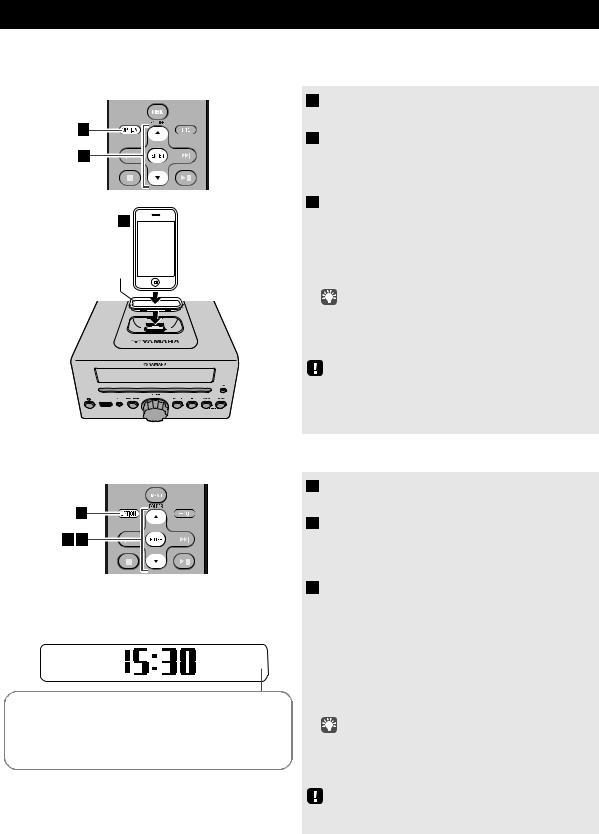
ADJUSTING THE CLOCK (OPTION MENU)
You’ll use the option menu ( P. 15) to set this unit’s date and time.
To copy the time from your iPod
1
2
3 
Dock adaptor ( P. 3)
1 Press OPTION.
The option menu will appear.
2Press / to select “CLOCK SET,” and then
press ENTER.
The display will indicate “CLOCK YEAR,” and the numerical value to be set will blink.
3Set your iPod in the iPod dock ( P. 3).
The time will be copied from your iPod to this unit.
Press ENTER to confirm the items in the order of year  month
month  day
day  hour
hour  minute.
minute.
When clock setting has finished, the display will indicate “Completed!”
•By pressing DISPLAY you can select the time format (12- hour/24-hour).
•The time will not be copied if the iPod is already connected or if the audio source is set to USB.
The time settings will be reset if the unit remains unpowered for about one hour.
Setting the clock manually
1
2 3
The clock is shown as below.
(24-hour)
2 6 A p r
Jan |
Feb |
Mar |
Apr |
May |
Jun |
|
|
|
|
|
|
January |
February |
March |
April |
May |
June |
Jul |
Aug |
Sep |
Oct |
Nov |
Dec |
|
|
|
|
|
|
July |
August |
September |
October |
November |
December |
1 Press OPTION.
The option menu will appear.
2Press / to select “CLOCK SET,” and then
press ENTER.
The display will indicate “CLOCK YEAR,” and the numerical value to be set will blink.
3Set the date and time.
Press / to edit each numerical value, and then press ENTER to confirm the setting.
Set the items in the order of year  month
month  day
day  hour
hour  minute.
minute.
When clock setting has finished, the display will indicate “Completed!”
The clock will be set to 0 second the moment you complete the clock settings.
•While making these settings, you can press DISPLAY to select the time format (12-hour/24-hour).
•If you decide to cancel without changing the setting, press OPTION before confirming the change.
The time settings will be reset if the unit remains unpowered for about one hour.
6 En

??
LISTENING TO YOUR iPod
Playing music from your iPod
• For details on compatible iPod models, refer to “SPECIFICATIONS” (P. 23). |
English |
|
• Your iPod can also play back music and charge while connected to the USB port. To do this, select USB as the audio source |
||
|
||
( P. 10). |
|
1
2 
Dock adaptor ( P. 3) 
1 Press the iPod source button to switch the audio source to iPod.
2 Set your iPod in the iPod dock ( P. 3).
3 Play the iPod.
Playback can be controlled with either the remote control, iPod or the front panel on this unit ( P. 4, 5).
•If you’ve selected an audio source other than USB, performing the following operations will automatically switch the audio source to iPod and start playback even if the system is turned off.
−Connect your iPod in the playback state to the iPod dock.
−Play back the connected iPod.
•If USB is selected as the audio source, the iPod will not be recharged.
•You can remove the iPod during playback.
•If iPod is selected as the audio source, this unit will automatically turn the system off when 60 minutes have elapsed without a device being connected to the iPod dock nor any operation performed.
iPod menu operations (remote control only)
You can use the remote control to operate your iPod.
MENU: Switch menu items/Return to the previous menu /: Move between items in the menu
ENTER: Confirm
Display information (remote control only)
If you press DISPLAY on the remote control while a song is playing or paused, the information shown on the front panel display will be switched in the following order.
 Elapsed song playback time
Elapsed song playback time
Song name
Album name
Artist name
7 En
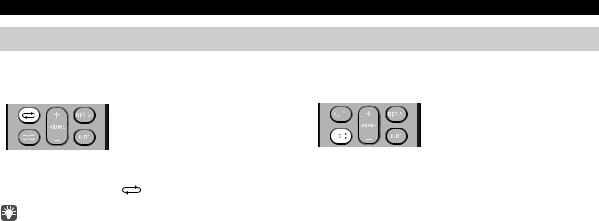
LISTENING TO YOUR iPod
Using repeat/shuffle playback (remote control only)
The playback status is shown by the repeat/shuffle indicator in the front panel display.
Repeat playback
Press  (repeat) repeatedly to select one of the following
(repeat) repeatedly to select one of the following
playback modes.
No display: Off

 : One
: One 
 : All
: All
Shuffle playback
Press  (shuffle) repeatedly to select one of the following
(shuffle) repeatedly to select one of the following
playback modes.
No display: Off
 : Songs
: Songs  : Albums
: Albums
The operation or display of repeat/shuffle may differ, depending on the type or software version of iPod used.
8 En
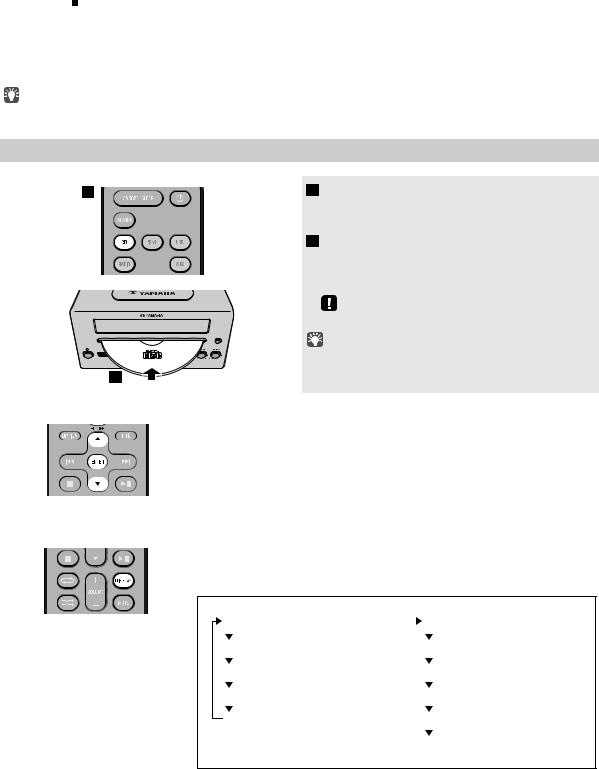
|
LISTENING TO CD AND USB DEVICES |
|
|
|
|
|
|
The unit will operate as follows when playing back tracks/files on CD/USB devices. |
|
|
|
• If the CD/USB device being played is stopped, the track that you listened will start playback from the beginning of the |
|
English |
|
track the next time you play. |
|
||
• If you press |
while playback is stopped, tracks will play as follows the next time playback begins: |
|
|
|
|
||
− Audio CD: |
from the first track of the CD. |
|
|
− Data CD*/USB device: from the first track of the folder contains the track you listened to last time. |
|
|
|
• This unit automatically turns off the system if no operation has been performed for 60 minutes after CD/USB device |
|
|
|
playback is stopped. |
|
|
|
* “Data CD” is a CD that contains MP3/WMA files. |
|
|
|
For details on playable discs and files, refer to “NOTES ON DISCS AND USB DEVICES” (P. 22). |
|
|
|
|
|
|
|
Listening to a CD
1 1 Press the CD source button to switch the
audio source to CD.
If a CD is already inserted, playback will start.
2 Insert a CD into the disc slot.
Playback starts automatically.
Playback can be controlled with either the remote control, or the front panel on this unit ( P. 4, 5).
Insert the CD with the label side facing upward.
Folders and files on a data CD are played in alphabetical order.
2
Skipping folders (remote control only)
While a data CD is playing, you can use the remote control’s FOLDER / buttons to select the folder.
Display information (remote control only)
The folder number (only for a data CD) or the song/file number is shown for several seconds when starting playback or skipping tracks.
If you press DISPLAY on the remote control while a song is playing or paused, the information shown on the front panel display will be switched in the following order.
Audio CD |
|
|
Data CD |
||
Elapsed song playback time |
|
|
Elapsed song playback time |
||
|
|
||||
|
|
|
|
|
|
|
|
|
|
|
|
Remaining song playback time |
|
|
Song name* |
||
|
|
|
|
|
|
|
|
|
|
|
|
Song name* |
|
|
Album name* |
||
|
|
|
|
|
|
|
|
|
|
|
|
Album name* |
|
|
Artist name* |
||
|
|
|
|
|
|
|
|
|
|
|
|
Artist name* |
|
|
File name |
||
|
|
|
|
|
|
|
|
|
|
|
|
|
|
|
|
Folder name |
|
|
|
|
|
||
* Shown only if this data is included in the song.
9 En

LISTENING TO CD AND USB DEVICES
Listening to a USB device
1
2 
1 Press the USB source button to switch the
audio source to USB.
If a USB device is already connected, playback will start.
2 Connect a USB device to the USB port.
Playback starts automatically.
Playback can be controlled using either the remote control, the front panel on this unit, or the USB device ( P. 4, 5).
•Folders and files will play in the order in which they were written.
•Your iPod/iPhone/iPad can also play back music and charge while connected to the USB port.
Stop playback before disconnecting the USB device.
Skipping folders (remote control only)
While a USB device is playing, you can use the remote control’s FOLDER / buttons to select the folder.
Display information (remote control only)
The folder/file number is shown for several seconds when starting playback or skipping tracks.
If you press DISPLAY on the remote control while a song is playing or paused, the information shown on the front panel display will be switched in the following order.
 Elapsed song playback time
Elapsed song playback time
Song name*
Album name*
Artist name*
File name
Folder name
* Shown only if this data is included in the song.
Using repeat/shuffle playback (remote control only)
The playback status is shown by the repeat/shuffle indicator in the front panel display.
Repeat playback
Press  (repeat) repeatedly to select one of the following playback modes.
(repeat) repeatedly to select one of the following playback modes.
No display: Repeat mode off
: |
1 track |
 : All tracks within the folder (data CD/ USB device only)
: All tracks within the folder (data CD/ USB device only)


 : All tracks
: All tracks
Shuffle playback
Press  (shuffle) repeatedly to select one of the following playback modes.
(shuffle) repeatedly to select one of the following playback modes.
No display: Shuffle mode off
 : All tracks within the folder (data CD/ USB device only)
: All tracks within the folder (data CD/ USB device only)



 : All tracks
: All tracks
10 En
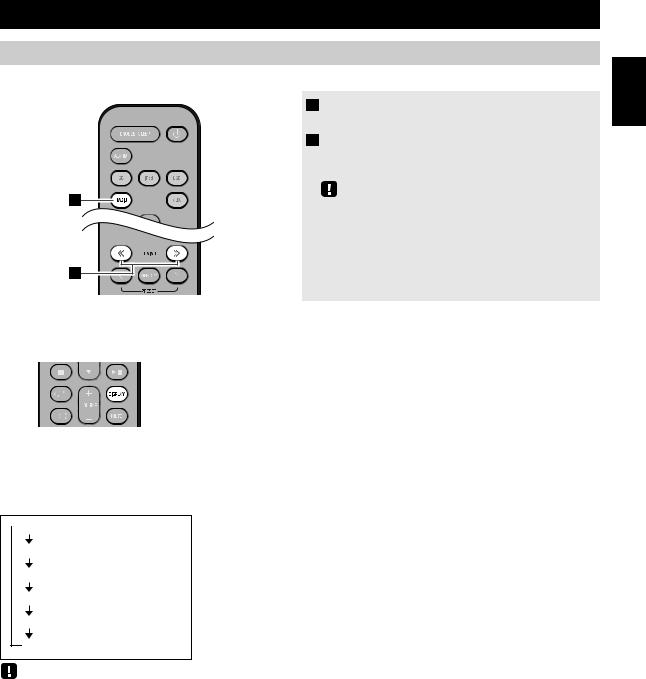
LISTENING TO FM STATIONS
Selecting an FM station
To listen to a FM station, connect the antenna as described in “Connecting the speakers and antenna” (P. 2).
1 Press the RADIO source button to switch the audio source to FM.
2 Tune FM stations
Automatic tuning: Press and hold TUNING  /
/  . Manual tuning: Press TUNING
. Manual tuning: Press TUNING  /
/  repeatedly.
repeatedly.
1 |
If you tune to a station manually while receiving FM, the sound |
|
will be monaural. |
2
Display information (remote control only)
If you press DISPLAY on the remote control, the information shown on the front panel display will be switched in the following order.
Preset number and frequency 
 Reception status*
Reception status*
* Example of reception status indication.
TUNED/STEREO: A strong FM stereo broadcast is being received.
TUNED/MONO: A monaural FM broadcast is being received (even if the FM broadcast is stereo, reception will be monaural if the signal is weak).
Not TUNED: No broadcast is being received.
Displaying Radio Data System information
If you press DISPLAY on the remote control while Radio Data System information is being received, the information shown on the front panel display will be switched in the following order.
 PS (Program Service)
PS (Program Service)
PTY (Program Type)
RT (Radio Text)
CT (Clock Time)
Reception status
Preset number and frequency
If the signal transmission of the Radio Data System station is too weak, this unit may not be able to receive Radio Data System information completely. In particular, RT (Radio Text) information uses a lot of bandwidth, so it may be less available compared to other types of information.
English
11 En
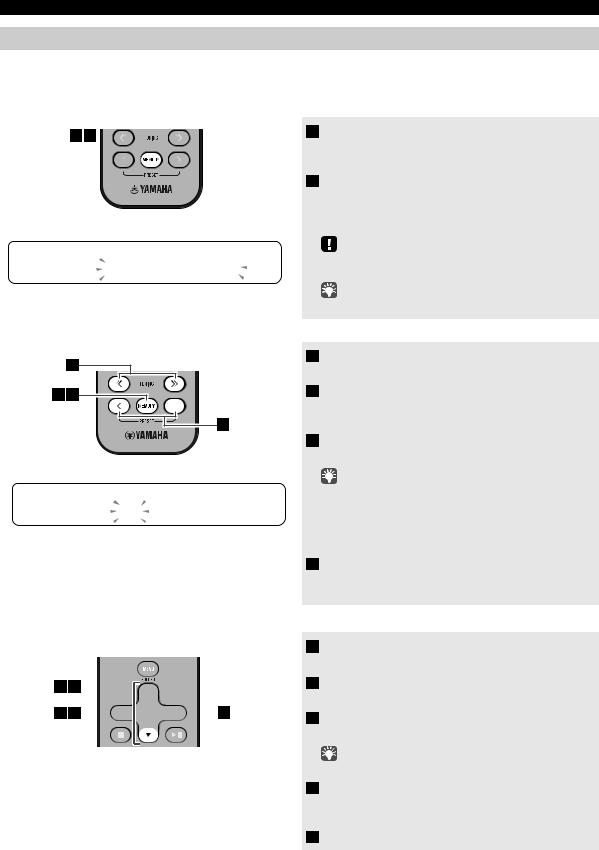
LISTENING TO FM STATIONS
Presetting FM stations (remote control only)
Use the preset function to store your favorite 30 stations.
Auto preset
This method tunes automatically, and automatically presets only the stations that have good reception.
1 2
A U T O P R E S E T  P r e s s M E M O R Y
P r e s s M E M O R Y
1Press and hold down MEMORY.
“AUTO PRESET” will appear and “Press MEMORY” will blink.
2Press MEMORY.
Auto preset will begin.
When presetting has finished, the display will indicate “Completed!”
When you perform auto preset, all stored stations are cleared and the new stations are stored.
If you want to stop auto preset before it is completed, press  .
.
Manual preset
1
2 4
3
P R E S E T M E M O R Y
F M 0 1 8 7 . 5 0 M H z
Deleting a stored preset (Option menu)
15 





23 


 4
4
1 Press TUNING  /
/  to tune a station that you want to preset.
to tune a station that you want to preset.
2 Press MEMORY.
The display will indicate “PRESET MEMORY,” and the preset number will blink.
3 Press PRESET  /
/  to select the preset number that you want to store.
to select the preset number that you want to store.
•The lowest preset number that has not been stored will be selected first.
•If you want to cancel the presetting, press  .
.
•If you select a preset number in which a station has already been stored, it will be overwritten by the new station.
4 Press MEMORY.
When presetting has finished, the display will indicate “Completed!”
1 Press OPTION.
The option menu will appear.
2Press / to select PRESET DELETE, and then press ENTER.
3Press / to select the preset number that you want to delete.
If you want to cancel the deleting, press OPTION.
4 Press ENTER to complete the operation.
When deleting has finished, the display will indicate “Deleted!”.
5 Press OPTION to exit the option menu.
12 En
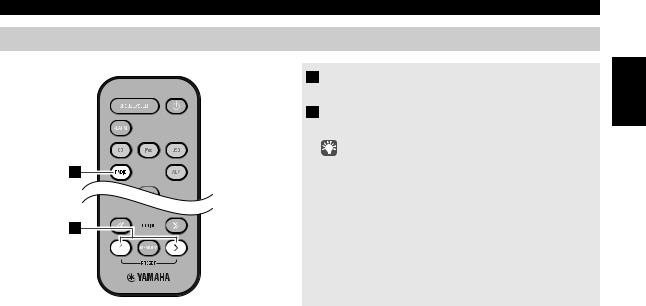
LISTENING TO FM STATIONS
Selecting preset FM stations
1 Press the RADIO source button to switch the audio source to FM.
2 Press PRESET  /
/  to select the FM station that you want to hear.
to select the FM station that you want to hear.
You can only select presets that have been stored.
1
2
English
13 En
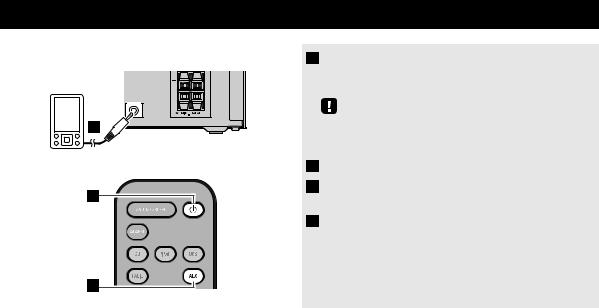
LISTENING TO EXTERNAL SOURCES |
||
Rear panel |
1 Using a commercially available 3.5 mm mini- |
|
|
plug cable, connect your external device to the |
|
|
AUX jack on the rear panel of this unit. |
|
AUX IN |
|
|
1 |
• Turn off the system before connecting the audio cable. |
|
• Turn down the volume of the unit and your external audio |
||
|
||
|
device before connection. |
|
2 Press  to turn the system on.
to turn the system on.
3 Press the AUX source button to switch the
2 |
audio source to AUX. |
|
4 Start playback on the connected external audio device.
3
14 En

USEFUL FUNCTIONS
Using the Option menu
When you press OPTION, the option menu will appear in the front panel display, allowing you to make the following settings.
 (eject button) cannot be operated while the option menu is displayed.
(eject button) cannot be operated while the option menu is displayed.
Option menu |
|
Setting or range |
See page |
PRESET DELETE |
Deletes a stored preset (shown only if the audio source is FM). |
12 |
|
|
|
|
|
DIMMER |
Adjusts the brightness of the front panel display (*1: bright, 2: medium, 3: dim). |
– |
|
|
|
|
|
EQ LOW |
Adjusts the tonal character (low frequencies) (–10 - 0* - +10 dB). |
– |
|
|
|
|
|
EQ MID |
Adjusts the tonal character (mid frequencies) (–10 - 0* - +10 dB). |
– |
|
|
|
|
|
EQ HIGH |
Adjusts the tonal character (high frequencies) (–10 - 0* - +10 dB). |
– |
|
|
|
|
|
BALANCE |
Adjusts the volume balance of the left and right speakers (L+10 - CENTER* - R+10). |
– |
|
|
|
|
|
POWER SAVING |
Switches the system-off state |
|
|
|
NORMAL: |
Show the clock |
|
|
|
An iPod can be charged in the iPod Dock, and the alarm will operate |
– |
|
|
|
|
|
ECO*: |
No clock display |
|
|
(power saving mode) |
An iPod can be charged in the iPod Dock, but the alarm will not operate |
|
|
|
|
|
AUTO POWER |
You can specify the time after which the system will turn off automatically. |
|
|
OFF |
If no operation occurs for the duration you specify, the system will turn off automatically |
– |
|
|
(TIME 12H*: 12 hours, TIME 8H: 8 hours, TIME 4H: 4 hours, OFF: the system will not turn off). |
|
|
|
|
|
|
CLOCK SET |
Sets the date and time. |
|
6 |
|
|
|
|
ALARM SET |
Sets the alarm. |
|
17 |
|
|
|
|
* Default setting
Procedure for settings
|
|
|
|
|
|
|
1 |
Press OPTION. |
|
|
|
|
|
|
|
|
The option menu will appear. |
|
|
|
|
|
|
|
|
Press / to select the menu item that you |
1 |
4 |
|
|
|
|
2 |
||
|
|
|
|
|||||
|
|
|
|
|
|
|||
|
|
|
|
|
|
|
|
want to set, and then press ENTER. |
2 3
3 Press / to edit the setting, and then press
ENTER to confirm the setting.
If you want to continue making other settings, repeat the procedure from step 2 .
4 Press OPTION to exit the option menu.
If you decide to cancel without changing the setting, press
OPTION before confirming the change.
Using the sleep timer
When the specified time has elapsed, the system will turn off automatically.
Press repeatedly |
Press SNOOZE/SLEEP repeatedly to specify the |
|
time after which the system will turn off. |
||
|
||
|
You can specify 30, 60, 90, 120 or OFF. |
|
|
When you select a time, the sleep timer is turned on, and the |
|
|
sleep indicator ( ) is shown in the front panel display. |
|
|
If you press SNOOZE/SLEEP while the sleep timer is activated, |
|
|
the sleep timer setting will be canceled. |
English
15 En

USEFUL FUNCTIONS
Using the alarm function
The unit includes an alarm function (IntelliAlarm) that plays back audio sources or a set of beep (internal alarm sound) at the set time using a variety of different methods. The alarm function has the following features.
3 types of alarms
Select from 3 alarm types, combining music and beep sounds.
SOURCE+BEEP |
The selected audio source and the beep sound are played at the set time. Source playback begins to fade in 3 |
|
minutes before the set time and the volume gradually increases to the set volume. Then, at the set time, the beep |
||
|
sound is activated. |
|
SOURCE |
The selected audio source is played at the set time. The volume fades in gradually and increases to the set |
|
volume. |
||
|
||
BEEP |
The beep sound is played at the set time. |
Various audio sources
You can choose from iPod, audio CD, data CD, USB device, or FM. The following playback methods can also be selected depending on the audio source:
Source |
Playback |
Function |
|
method |
|||
|
|
||
|
|
A specific playlist stored on the iPod is played back repeatedly. To play a playlist, create a |
|
|
Playlist* |
playlist with the name “ALARM Yamaha DTA” in advance. |
|
iPod |
When entering the playlist name, use single-byte spaces to separate words, and enter |
||
|
|||
|
single-byte characters, taking care that uppercase/lowercase letters are used correctly. |
||
|
|
||
|
|
|
|
|
Resume |
If the “ALARM Yamaha DTA” playlist cannot be found within the iPod, the unit |
|
|
resumes play from the last track you played. |
||
|
|
||
Audio CD |
Selected track |
The selected track is played repeatedly. |
|
Resume |
The track you listened to last time is played back. |
||
|
|||
Data CD/USB device |
Folder |
The selected folder is played repeatedly. |
|
Resume |
The track you listened to last time is played back. |
||
|
|||
FM |
Preset station |
The selected preset station is played. |
|
Resume |
The FM station you listened to last time is played back. |
||
|
* For information on creating a playlist, refer to the instructions for your iPod or iTunes.
Snooze
The snooze function can be enabled to replay the alarm after 5 minutes ( P. 18).
Using “DTA Controller” to set the alarm
By using the free “DTA Controller” application for the iPod touch/iPhone/iPad, you can make detailed alarm settings that cannot be made using this unit by itself. For each day of the week, you can specify the alarm time (Weekly Alarm), and adjust the IntelliAlarm as desired.
The front panel display shows information for the Weekly Alarm you’ve set.
MON |
TUE |
WED |
THU |
FRI |
SAT |
SUN |
|
|
|
|
|
|
|
Monday |
Tuesday |
Wednesday |
Thursday |
Friday |
Saturday |
Sunday |
For details, refer to the description of “DTA Controller” in the product webpage.
16 En

USEFUL FUNCTIONS
Setting the alarm
Setting the alarm time and alarm type (Option menu)
The alarm will not function when the unit is in power saving ( P. 15). To use the alarm function, set the Option menu item POWER SAVING to NORMAL.
1
2 3
4
Alarm time
9 : 1 2 

C o m p l e t e d !
Alarm indicator
1Press OPTION.
The option menu will appear.
2Press / to select “ALARM SET”, and then press ENTER.
The alarm indicator (



 ) and numerical value you’re setting will blink.
) and numerical value you’re setting will blink.
3Set the alarm.
Set items 1-5 described below.
Press / to select a numerical value, and press ENTER to confirm it.
Items |
Setting or range |
||
1 ALARM SELECT |
* This can be selected after you’ve used the “DTA |
||
|
Controller” to set the alarm ( P. 16). |
||
|
If you’re not using the “DTA Controller”, proceed to 2. |
||
|
ONE DAY: An alarm that sounds only once at the |
||
|
specified time. |
||
|
WEEKLY: An alarm whose time can be specified for |
||
|
each day of the week (settable only using |
||
|
“DTA Controller”). |
||
|
If you’ve chosen WEEKLY, this completes the alarm |
||
|
setting. |
||
2 ALARM TIME |
Make settings in the order of hours |
|
minutes. |
|
|||
|
|
|
|
3 ALARM TYPE |
Select from SOURCE+BEEP, SOURCE or BEEP. For |
||
|
details, refer to “3 types of alarms” (P. 16). |
||
|
If you selected BEEP, proceed to item 5. |
||
|
|
|
|
4 SOURCE |
iPod: Play back music from your iPod (refer to |
||
(If you selected |
“Various audio sources” (P. 16)). |
||
SOURCE+BEEP or |
CD: Play back music from a CD. |
||
SOURCE as the |
Specify the track number (data CD: folder |
||
alarm type) |
number) (RESUME, 1-99). |
||
|
USB: Play back music from a USB device. |
||
|
Specify the folder number (RESUME, 1-999). |
||
|
FM: Play a FM station. |
||
|
Specify the preset number (RESUME, 1-30). |
||
|
If the selected source cannot be played back at the time set |
||
|
for the alarm (e.g., the iPod is not connected), the beep |
||
|
sound is played back. |
||
|
If you choose RESUME when specifying the track/folder/ |
||
|
preset number, the last-played track/folder/station will be |
||
|
played (resume playback). |
||
5 VOLUME |
Specifies the volume (5-60) of the alarm. |
||
|
|
|
|
4 Complete the settings.
When you set the VOLUME for item 5, the display will indicate “Completed!” and your settings will be confirmed.
The alarm will be turned on and the alarm indicator (



 ) will light.
) will light.
If you press OPTION or turn off the system while making alarm settings, the settings will be cancelled.
English
17 En
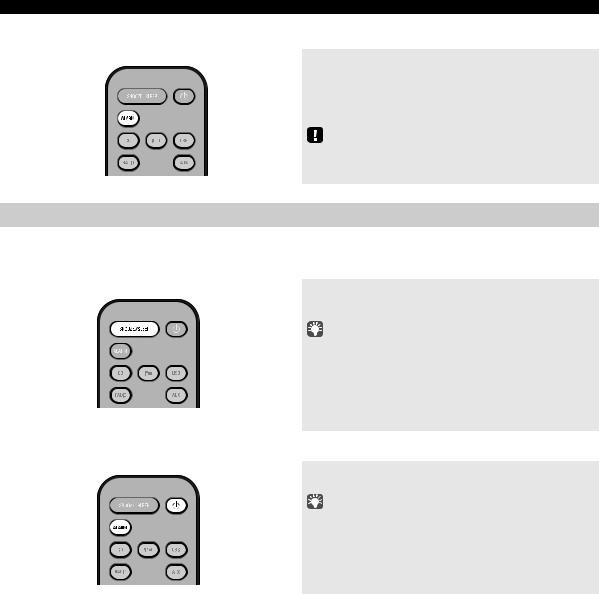
USEFUL FUNCTIONS
Switching the alarm on/off
Press ALARM to turn the alarm on/off.
When the alarm is on, the alarm indicator (



 ) will light, and the alarm time will be shown. If you press ALARM again, the alarm indicator (
) will light, and the alarm time will be shown. If you press ALARM again, the alarm indicator (



 ) and the alarm will turn off.
) and the alarm will turn off.
If the Option menu item POWER SAVING is set to ECO, the alarm will not function ( P. 15).
Operations while the alarm sound is playing
When the set time arrives, the selected alarm sound will play. During playback, the following operations are available.
To pause the alarm (Snooze)
Press SNOOZE/SLEEP.
Snooze will stop the alarm and play it again 5 minutes later.
• If SOURCE + BEEP is set as the alarm type, you can press SNOOZE/SLEEP once to stop the beep sound, and twice to stop the audio source.
Five minutes after the audio source is stopped, it will start fading in again and the beep sound will resume.
• Buttons on the unit other than the  will also function as the snooze button.
will also function as the snooze button.
To turn the alarm off
Press ALARM or  .
.
• You can also stop the alarm by holding down SNOOZE/SLEEP.
• If you don’t stop the alarm, it will stop automatically after 60 minutes and the system will turn off.
• The alarm setting will be saved even if the alarm is turned off. If the alarm is turned on again by pressing ALARM, the alarm will sound with the previous alarm settings.
18 En

TROUBLESHOOTING
If there is a problem with the unit, check the following list first. If you cannot resolve the problem with the suggested solutions or if the problem is not listed below, turn off and unplug the system, and consult the nearest authorized Yamaha dealer or service center.
General
Problem |
Cause |
Solution |
|
|
|
|
|
The speakers make no sound. |
The volume might be set to the minimum level, |
Adjust the volume level. |
|
|
or muted. |
|
|
|
|
|
|
|
The source may be incorrect. |
Select the correct source. |
|
|
|
|
|
|
The speakers may not be connected securely. |
Check the connections ( P. 2). |
|
|
|
|
|
|
Headphones are connected. |
Remove the headphones. |
|
|
|
|
|
|
The volume of a connected external device is not |
Raise the volume of the external device. |
|
|
loud enough. |
|
|
|
|
|
|
Sound suddenly turns off. |
The sleep timer may be set ( P. 15). |
Turn the system on and play the source again. |
|
|
|
|
|
|
The automatic system-off function may have |
When the time specified for AUTO POWER OFF in the |
|
|
operated. |
option menu has elapsed ( P. 15) or when 60 minutes |
|
|
|
have elapsed without any operation being performed after |
|
|
|
stopping USB device or CD playback, the unit will turn the |
|
|
|
system off automatically. |
|
|
|
|
|
Sound is cracked/distorted or |
Input source volume is excessive, or volume of |
Adjust volume with VOLUME, or use the option menu |
|
there is abnormal noise. |
this unit is excessive (especially Bass). |
( P. 15) to adjust the bass range. If an external device is |
|
|
|
playing back, lower the volume of the external device. |
|
|
|
|
|
The unit does not operate |
The unit may have received a strong electrical |
Restart the system by holding down the |
for about 10 |
properly. |
shock such as lightning or excessive static |
seconds. |
|
|
electricity, or power supply may have dropped. |
|
|
The system turns on but |
|
|
|
|
|
|
|
immediately shuts off. |
|
|
|
|
|
|
|
A digital or high-frequency |
The unit may be placed too close to the digital or |
Place the unit farther away from the equipment. |
|
equipment produces noises. |
high-frequency equipment. |
|
|
|
|
|
|
The clock setting has been |
The unit was left for about one hour with the |
Plug the power cable into the wall outlet firmly, and set the |
|
cleared. |
power cable disconnected from the wall outlet. |
clock again ( P. 6). |
|
|
|
|
|
The iPod does not play back at |
The iPod is not set in the iPod dock. |
Set the iPod in the iPod dock ( P. 3). |
|
the alarm time even if the alarm |
|
|
|
source is set to iPod. |
|
|
|
|
|
|
|
Alarm does not sound. |
The unit is set to power saving mode. |
In the option menu, set POWER SAVING to NORMAL |
|
|
|
( P. 15). |
|
The front panel display indicates |
|
|
|
|
|
|
|
“ALARM not work” and can’t |
|
|
|
set the alarm. |
|
|
|
|
|
|
|
The unit turns the system off |
The automatic system-off function may have |
When the time specified for AUTO POWER OFF in the |
|
unexpectedly. |
operated. |
option menu has elapsed ( P. 15) or when 60 minutes |
|
|
|
have elapsed without any operation being performed after |
|
|
|
stopping USB device or CD playback, the unit will turn the |
|
|
|
system off automatically. |
|
|
|
|
|
English
19 En
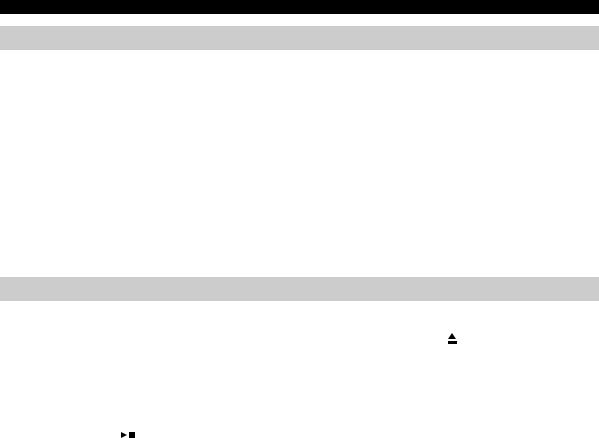
TROUBLESHOOTING
iPod
Problem |
Cause |
Solution |
|
|
|
No sound. |
The iPod is not set in the iPod dock firmly. |
Remove the iPod from the unit, and then set it in the iPod |
|
|
dock again ( P. 3). |
|
|
|
|
The headphones of the iPod are connected. |
Remove the Headphones. |
|
|
|
|
The iPod software version has not been updated. |
Download the latest iTunes software to update the iPod |
|
|
software version to the latest. |
|
|
|
The iPod does not charge up. |
The iPod is not set in the iPod dock firmly. |
Remove the iPod from the unit, and then set it in the iPod |
|
|
dock again ( P. 3). |
|
|
|
|
USB is selected as the audio source. |
Select something other than USB as the audio source. |
|
|
|
The front panel display indicates |
The iPod being used is not supported by the unit. |
Use a supported iPod ( P. 23). |
“iPod Unknown” when you |
|
|
connect the iPod. |
|
|
|
|
|
Disc playback
Problem |
Cause |
Solution |
|
|
|
|
|
Disc cannot be inserted. |
Another disc is already inserted. |
Unload the disc with . |
|
|
|
|
|
|
You are attempting to insert a disc that cannot be |
Use a disc supported by the unit ( P. 22). |
|
|
used by this unit. |
|
|
|
|
|
|
Some button operations do not |
The disc loaded into the unit may not be |
Use a disc supported by the unit ( P. 22). |
|
work. |
compatible. |
|
|
|
|
|
|
Playback does not start |
The disc may be dirty. |
Wipe the disc clean ( P. 22). |
|
immediately after pressing |
|
|
|
The disc loaded into the unit may not be |
Use a disc supported by the unit ( P. 22). |
||
(stops immediately). |
|||
|
compatible. |
|
|
|
|
|
|
|
If the unit was moved from a cold to warm place, |
Wait for an hour or two until the unit adjusts to the room |
|
|
condensation may have formed on the disc |
temperature, and try again. |
|
|
reading lens. |
|
|
|
|
|
|
The front panel display indicates |
The option menu is displayed. Alternatively, the |
Press OPTION to exit the option menu. Alternatively, |
|
“no operation”, and a disc cannot |
alarm is playing. |
press ALARM to stop the alarm. |
|
be inserted or unloaded. |
|
|
|
|
|
|
|
When you insert a disk, the front |
The disc loaded into the unit may not be |
Use a disc supported by the unit ( P. 22). |
|
panel display indicates “CD No |
compatible. |
|
|
Disc” or “CD Unknown.” |
|
|
|
The disc may be dirty. |
Wipe the disc clean ( P. 22). |
||
|
|||
|
|
|
|
|
The disc does not contain playable files. |
Use a disc contains playable files ( P. 22). |
|
|
|
|
|
|
The disc was inserted upside down. |
Insert the disc with the label facing upward. |
|
|
|
|
20 En
|
|
TROUBLESHOOTING |
|
|
|
|
|
|
|
USB device playback |
|
|
|
|
|
|
|
|
|
Problem |
Cause |
Solution |
|
English |
|
|
|
|
|
does not play. |
The USB device is not recognized. |
unit. |
|
|
MP3/WMA file in the USB device |
Turn the system off and reconnect the USB device to the |
|
|
|
|
|
If the solutions above do not resolve the problem, the USB |
|
|
|
|
device is not playable on the unit ( P. 22). |
|
|
|
|
|
|
|
|
|
|
|
|
|
The USB device does not contain playable files. |
Use a USB device contains playable files ( P. 22). |
|
|
|
|
|
|
|
When you connect a USB device, |
An incompatible USB device was connected to |
Turn the system off and reconnect the USB device to the |
|
|
the front panel display indicates |
the unit. Alternatively, the USB device is not |
unit. |
|
|
“USB OverCurrent,” and then |
connect firmly to the unit. |
If it does not resolve the problem, the USB device is not |
|
|
the front panel display goes |
|
playable on the unit ( P. 22). |
|
|
blank. |
|
|
|
|
|
|
|
|
|
|
|
|
|
|
FM reception |
|
|
|
|
|
|
|
|
|
Problem |
Cause |
Solution |
|
|
|
|
|
|
|
Too much noise. |
The antenna may be connected improperly. |
Make sure the antenna is connected properly ( P. 2) or |
|
|
|
|
use a commercially available outdoor antenna. |
|
|
|
|
|
|
|
|
The antenna is too close to the unit or to an |
Position the antenna as far away as possible from the unit |
|
|
|
electronic device. |
or the electronic device. |
|
|
|
|
|
|
|
Too much noise during stereo |
The radio station you selected may be far from |
Try manual tuning to improve the signal quality ( P. 11) |
|
|
broadcast. |
your area, or the radio wave reception is weak in |
or use a commercially available outdoor antenna. |
|
|
|
your area. |
|
|
|
|
|
|
|
|
Even with an outdoor antenna, |
Multipath reflection or other radio interferences |
Change the height, direction, or placement of the antenna |
|
|
radio wave reception is weak. |
may have occurred. |
( P. 2). |
|
|
(Sound is distorted.) |
|
|
|
|
|
|
|
|
|
|
|
|
|
|
Remote control |
|
|
|
|
|
|
|
|
|
Problem |
Cause |
Solution |
|
|
|
|
|
|
|
The remote control does not work |
The remote control may be operated outside its |
For information on the remote control operation range, |
|
|
properly. |
operation range. |
refer to “How to use the remote control” (P. 1). |
|
|
|
|
|
|
|
|
The remote control signal receiver on the unit |
Change the lighting or orientation of the unit. |
|
|
|
( P. 4) may be exposed to direct sunlight or |
|
|
|
|
lighting (inverted fluorescent lamps). |
|
|
|
|
|
|
|
|
|
The battery may be worn out. |
Replace the battery with a new one ( P. 1). |
|
|
|
|
|
|
|
|
There are obstacles between the remote control |
Remove the obstacles. |
|
|
|
signal receiver on the unit ( P. 4) and the |
|
|
|
|
remote control. |
|
|
|
|
|
|
|
|
21 En
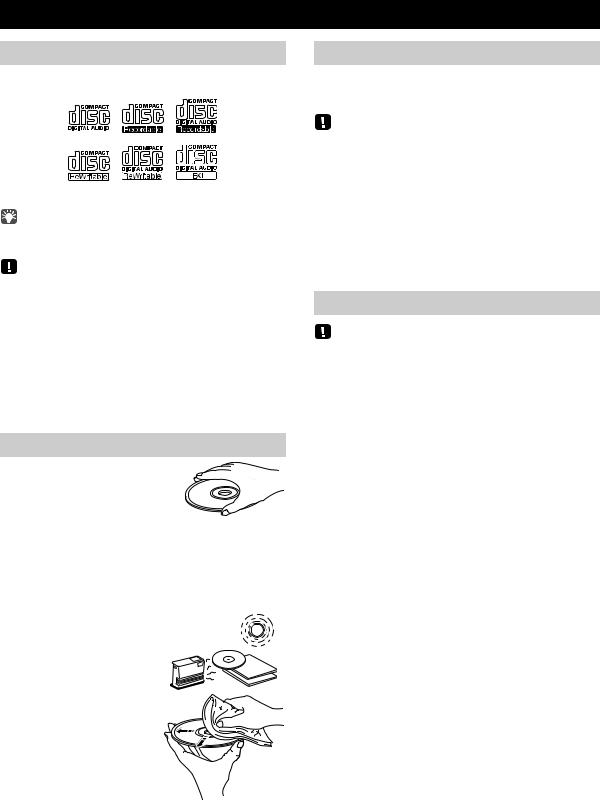
NOTES ON DISCS AND USB DEVICES
CD information
This unit is designed for use with audio CD, CD-R*, and CD-RW* with the logos followings.
* ISO 9660 format CD-R/RW
This unit can play back discs bearing any of the logo marks above. A disc logo mark is printed on the disc and the disc jacket.
•Do not load any other type of disc into this unit. Doing so may damage this unit.
•CD-R/RW cannot be played back unless finalized.
•Some discs cannot be played back depending on the disc characteristics or recording conditions.
•Do not use any non-standard shaped discs such as a heart-shaped disc.
•Do not use discs with many scratches on their surface.
•Do not load a cracked, warped, or glued disc.
•Do not use 8-cm discs.
Handling a disc
• Do not touch the surface of the disc. Hold a disc by its edge (and the center hole).
•Do not use a pencil or pointed marker to write on the disc.
•Do not put a tape, seal, glue, etc., on a disc.
•Do not use a protective cover to prevent scratches.
•Do not load more than one disc into this unit at one time. This can cause damage to both this unit and the discs.
•Do not insert any foreign objects into the disc slot.
• Do not expose a disc to direct |
|
sunlight, high temperature, |
Caution |
high humidity, or a lot of dust. |
• If a disc becomes dirty, wipe it with a clean, dry cloth from the center out to the edge. Do not use record cleaner or paint thinner.
•To avoid malfunction, do not use a commercially available lens cleaner.
USB device information
This unit supports USB mass storage class devices (e.g., flash memories or portable audio players) using FAT16 or FAT32 format.
•Some devices may not work properly even if they meet the requirements.
•Do not connect devices other than USB mass storage class devices (such as USB chargers or USB hubs), PCs, card readers, an external HDD, etc.
•Yamaha will not be held responsible for any damage to or data loss on the USB device occurring while the device is connected to this unit.
•Playability of and power supply to all kind of USB devices are not guaranteed.
•USB devices with encryption cannot be used.
About MP3 or WMA files
• The unit can play back:
File |
Bitrate (kbps) |
Sampling |
|
frequency (kHz) |
|||
|
|
||
|
|
|
|
MP3 |
8-320** |
16-48 |
|
|
|
|
|
WMA |
16-320** |
22.05-48 |
|
|
|
|
** Both constant and variable bitrates are supported.
• The maximum numbers of files/folders that can be played on the unit are as follows.
|
Data CD |
USB |
|
|
|
Maximum total number of file |
512 |
9999 |
|
|
|
Maximum folder number |
255 |
999 |
|
|
|
Maximum file number per folder |
511 |
255 |
|
|
|
• Copyright-protected files cannot be played back.
22 En

SPECIFICATIONS
PLAYER SECTION
iPod (Digital connection) [As of July, 2012]
• Compatible iPod models
..................................... iPod touch (1st, 2nd, 3rd and 4th generations) iPod nano (2nd, 3rd, 4th, 5th and 6th generations)
• Compatible iPhone models
......................... iPhone 4S, iPhone 4, iPhone 3GS, iPhone 3G, iPhone
• Compatible iPad models .............. iPad (3rd generation), iPad 2, iPad
An iPod may not be detected by the unit or some features may not be compatible, depending on the model or software version of the iPod.
CD
• Media............................................................................ |
CD, CD-R/RW |
• Audio format .................................................. |
Audio CD, MP3, WMA |
TUNER SECTION
Tuning range
• FM ......................................................................87.50 to 108.00 MHz
SPEAKER SECTION
• Type ................................................................... |
Full range bass reflex |
|
non magnetic shielding type |
• Driver....................................................... |
11 cm (4-1/2") cone type ×1 |
• Frequency response .................................... |
50 Hz to 20 kHz (–10 dB) |
• Dimensions (W × H × D) |
129 (5-1/8") × 126(5") × 251 (9-7/8") mm |
........................................... |
|
• Weight.......................................................................... |
1.7 kg (3.7 lbs.) |
USB
• Audio format .................................................................... MP3, WMA
AUX
• Input connector............................ 3.5 mm (1/8 in) STEREO mini jack
AMPLIFIER SECTION
• Maximum output power..........15 W + 15 W (6 Ω 1 kHz, 10 % THD)
•Headphones
..............3.5 mm (1/8 in) STEREO mini jack (Impedance 16 to 32 Ω)
GENERAL
• Power supply ............................................................ |
AC 230 V, 50 Hz |
• Power consumption ..................................................................... |
30 W |
• System off consumption
.................................. |
3.0 W or less (NORMAL)/0.5 W or less (ECO) |
• Dimensions (W × H × D) |
|
........................................ |
180 (7-1/8") × 127 (5") × 273 (10-3/4") mm |
• Weight.......................................................................... |
2.7 kg (6.0 lbs.) |
• Equalizer characteristics |
Specifications are subject to change without notice. |
EQ Low (Bass)/EQ Mid (Middle)/EQ High (Treble) .............. |
±10 dB |
iPod, iPhone, iPad
“Made for iPod”, “Made for iPhone” and “Made for iPad” mean that an electronic accessory has been designed to connect specifically to iPod, iPhone or iPad, respectively, and has been certified by the developer to meet Apple performance standards.
Apple is not responsible for the operation of this device or its compliance with safety and regulatory standards. Please note that the use of this accessory with iPod, iPhone or iPad may affect wireless performance.
iPad, iPhone, iPod, iPod classic, iPod nano, iPod touch and iTunes are trademarks of Apple Inc., registered in the U.S. and other countries.
LASER SAFETY
This unit employs a laser. Due to possible eye injury, only a qualified service person should remove the cover or attempt to service this device.
DANGER
This unit emits visible laser radiation when open. Avoid direct eye exposure to beam. When this unit is plugged into the wall outlet, do not place your eyes close to the opening of the disc slot and other openings to look into inside.
Information for Users on Collection and Disposal of Old Equipment and Used Batteries
These symbols on the products, packaging, and/or accompanying documents mean that used electrical and electronic products and batteries should not be mixed with general household waste.
For proper treatment, recovery and recycling of old products and used batteries, please take them to applicable collection points, in accordance with your national legislation and the Directives 2002/96/EC and 2006/66/EC.
By disposing of these products and batteries correctly, you will help to save valuable resources and prevent any potential negative effects on human health and the environment which could otherwise arise from inappropriate waste handling.
For more information about collection and recycling of old products and batteries, please contact your local municipality, your waste disposal service or the point of sale where you purchased the items.
[Information on Disposal in other Countries outside the European Union]
These symbols are only valid in the European Union. If you wish to discard these items, please contact your local authorities or dealer and ask for the correct method of disposal.
Note for the battery symbol (bottom two symbol examples):
This symbol might be used in combination with a chemical symbol. In this case it complies with the requirement set by the Directive for the chemical involved.
English
23 En

ATTENTION: VEUILLEZ LIRE CE QUI SUIT AVANT D’UTILISER L’APPAREIL.
1Pour utiliser l’appareil au mieux de ses possibilités, lisez attentivement ce mode d’emploi. Conservez-le soigneusement pour référence.
2Installez cet appareil dans un endroit frais, bien aéré, sec et propre - à l’abri de la lumière du soleil, des sources de chaleur, des vibrations, des poussières, de l’humidité et du froid. Pour une aération correcte, tenez compte des distances minimales suivantes.
Au-dessus: 15 cm
À l’arrière: 10 cm Sur les côtés: 10 cm
3Placez l’appareil loin des équipements, moteurs et transformateurs électriques, pour éviter les ronflements parasites.
4N’exposez pas l’appareil à des variations brutales de température, ne le placez pas dans un environnement très humide (par exemple dans une pièce contenant un humidificateur) car cela peut entraîner la condensation d’humidité à l’intérieur de l’appareil qui elle-même peut être responsable de décharge électrique, d’incendie, de dommage
àl’appareil ou de blessure corporelle.
5Evitez d’installer l’appareil dans un endroit où des objets peuvent tomber, ainsi que là où l’appareil pourrait être exposé
àdes éclaboussures ou des gouttes d’eau. Sur le dessus de l’appareil, ne placez pas:
–d’autres appareils qui peuvent endommager la surface de l’appareil ou provoquer sa décoloration.
–des objets se consumant (par exemple, une bougie) qui peuvent être responsables d’incendie, de dommage à l’appareil ou de blessure corporelle.
–des récipients contenant des liquides qui peuvent être à l’origine de décharge électrique ou de dommage à l’appareil.
6Ne couvrez pas l’appareil d’un journal, d’une nappe, d’un rideau, etc. car cela empêcherait l’évacuation de la chaleur. Toute augmentation de la température intérieure de l’appareil peut être responsable d’incendie, de dommage à l’appareil ou de blessure corporelle.
7Ne branchez pas la fiche du câble d’alimentation de l’appareil sur une prise secteur aussi longtemps que tous les raccordements n’ont pas été effectués.
8Ne pas faire fonctionner l’appareil à l’envers. Il risquerait de chauffer et d’être endommagé.
9N’exercez aucune force excessive sur les commutateurs, les boutons et les cordons.
10Pour débrancher la fiche du câble d’alimentation au niveau de la prise secteur, saisissez la fiche et ne tirez pas sur le cordon.
11Ne nettoyez pas l’appareil au moyen d’un solvant chimique, ce qui pourrait endommager la finition. Utilisez un chiffon sec et propre.
12N’alimentez l’appareil qu’à partir de la tension prescrite. Alimenter l’appareil sous une tension plus élevée est dangereux et peut être responsable d’incendie, de dommage à l’appareil ou de blessure corporelle. Yamaha ne saurait être tenue responsable des dommages résultant de l’alimentation de l’appareil sous une tension autre que celle prescrite.
13Pour empêcher tout dommage causé par les éclairs, déconnectez la câble d’alimentation et toute antenne extérieure de la prise murale pendant un orage.
14Ne tentez pas de modifier ni de réparer l’appareil. Consultez le service Yamaha compétent pour toute réparation qui serait requise. Le coffret de l’appareil ne doit jamais être ouvert, quelle que soit la raison.
15Si vous envisagez de ne pas vous servir de l’appareil pendant une longue période (par exemple, pendant les vacances), débranchez la fiche du câble d’alimentation au niveau de la prise secteur.
16Lisez la section intitulée “GUIDE DE DÉPANNAGE” où figurent une liste d’erreurs de manipulation communes avant de conclure que l’appareil présente une anomalie de fonctionnement.
17Avant de déplacer l’appareil, appuyez sur  pour éteindre le système puis débranchez la fiche du câble d’alimentation au niveau de la prise secteur.
pour éteindre le système puis débranchez la fiche du câble d’alimentation au niveau de la prise secteur.
18La condensation se forme lorsque la température ambiante change brusquement. En ce cas, débranchez la fiche du câble d’alimentation et laissez l’appareil reposer.
19La température de l’appareil peut augmenter en raison d’une utilisation prolongée. En ce cas, coupez l’alimentation de l’appareil et laissez-le au repos pour qu’il refroidisse.
20Installez cet appareil à proximité de la prise secteur et à un emplacement où la fiche du câble d’alimentation est facilement accessible.
21Les piles ne doivent pas être exposées à une chaleur extrême, par exemple au soleil, à une flamme, etc. Lors de la mise au rebut des piles, suivez vos réglementations locales.
–Conservez les piles hors de portée des enfants. Les piles constituent un danger potentiel si les enfants les mettent en bouche.
–Si les piles sont vieilles, la portée de la télécommande risque de diminuer considérablement. Le cas échéant, remplacez les piles le plus rapidement possible par deux piles neuves.
–N’utilisez pas à la fois des piles neuves et des piles usagées.
–N’utilisez pas non plus des piles de deux types différents (par exemple, des piles alcalines et des piles au manganèse). Lisez les instructions de l’emballage, car ces types de piles peuvent être de forme et de couleur différentes.
–Des piles épuisées risquent de fuir. En cas de fuite, jetez les piles immédiatement. Évitez de toucher le liquide qui a fui et veillez à ce qu’il n’entre pas en contact avec vos vêtements, etc. Nettoyez soigneusement le logement d’insertion des piles avant d’insérer de nouvelles piles.
–Retirez les piles de l’appareil si vous n’avez pas l’intention d’utiliser ce dernier pendant une période prolongée. Sans cela, les piles s’usent et risquent de fuir, ce qui pourrait endommager l’appareil.
–Ne jetez pas les piles avec les ordures ménagères. Mettez-les au rebut conformément aux réglementations locales en vigueur.
22Une pression excessive du son par les écouteurs et le casque d’écoute peut entraîner la perte de l’ouïe.
Cet appareil n’est pas déconnecté du secteur tant qu’il reste branché à la prise de courant, même si l’appareil en soi est éteint par la touche  . Dans cet état, l’appareil consomme une très faible quantité de courant.
. Dans cet état, l’appareil consomme une très faible quantité de courant.
AVERTISSEMENT
POUR RÉDUIRE LES RISQUES D’INCENDIE OU DE DÉCHARGE ÉLECTRIQUE, N’EXPOSEZ PAS CET APPAREIL À LA PLUIE OU À L’HUMIDITÉ.
ATTENTION
Danger d’explosion si la pile n’est pas remplacée correctement. La remplacer par une pile de type identique ou équivalent.
Il y a un risque possible de création d’interférences, visibles sur les images en couleurs si cet appareil est placé à côté d’un téléviseur à tube cathodique (tube de Braun). Dans ce cas, éloigner l’unité du téléviseur.
LASER |
|
Type |
Laser semi-conducteur GaAs/GaAlAs |
Longueur d’onde |
790 nm |
Puissance de sortie |
7 mW |
|
|
i Fr

TABLE DES MATIÈRES
CONNEXIONS........................................................... |
2 |
Connexion des haut-parleurs et de l’antenne ................ |
2 |
Connexion du cordon d’alimentation.............................. |
2 |
Autres connexions.......................................................... |
3 |
NOM ET FONCTIONS DES ÉLÉMENTS.................. |
4 |
Panneau supérieur / panneau avant.............................. |
4 |
Afficheur......................................................................... |
4 |
Télécommande .............................................................. |
5 |
RÉGLAGE DE L’HORLOGE (MENU OPTION) ........ |
6 |
ÉCOUTER UN iPod .................................................. |
7 |
Écouter la musique d’un iPod ........................................ |
7 |
Utilisation des modes de lecture répétée/aléatoire |
|
(télécommande uniquement) ......................................... |
8 |
ÉCOUTE DE STATIONS FM .................................. |
11 |
Sélection d’une station FM........................................... |
11 |
Présélection de stations FM |
|
(télécommande uniquement) ....................................... |
12 |
Sélection de stations FM mémorisées ......................... |
13 |
ÉCOUTE DE SOURCES EXTERNES..................... |
13 |
FONCTIONS UTILES.............................................. |
14 |
Utilisation du menu Option ........................................... |
14 |
Utilisation de la minuterie ............................................. |
15 |
Utilisation de la fonction d’alarme ................................ |
16 |
Réglage de l’alarme avec “DTA Controller” ................. |
16 |
Réglage de l’alarme ..................................................... |
17 |
Opérations disponibles quand l’alarme retentit ............ |
18 |
ÉCOUTE D’UN CD ET D’APPAREILS USB............. |
9 |
GUIDE DE DÉPANNAGE ....................................... |
19 |
Écoute d’un CD.............................................................. |
9 |
REMARQUES SUR LES DISQUES |
|
Écoute d’un appareil USB............................................ |
10 |
ET APPAREILS USB .............................................. |
22 |
Utilisation des modes de lecture répétée/aléatoire |
|
CARACTÉRISTIQUES TECHNIQUES ................... |
23 |
(télécommande uniquement) ....................................... |
10 |
|
|
|
|
|
|
Caractéristiques
•Lecture de plages de dispositifs externes tels que iPod/iPhone/iPad, de CD de musique/données, de plages de dispositifs USB ou d’appareils externes raccordés à la prise AUX, et écoute de la radio FM.
•Réveillez-vous avec votre musique préférée ou une sonnerie - ou les deux. À l’heure programmée,la plage choisie est lue au volume prédéfini, pour le meilleur des réveils (fonction IntelliAlarm).
•Vous pouvez en outre exploiter d’autres réglages d’alarme plus sophistiqués par le biais de l’application gratuite “DTA Controller” pour iPod touch/iPhone/iPad ( P.16).
•Mémorisez et rappelez vos 30 stations FM préférées en toute facilité.
•Réglez le grave, le médium et l’aigu comme bon vous semble.
Quelques mots sur ce mode d’emploi
•Les passages de ce manuel faisant référence à l’iPod désignent aussi l’iPhone.
•Pour les fonctions pilotables via les boutons de l’appareil ou les touches de sa télécommande, ce manuel décrit l’utilisation de la télécommande.
• signale les précautions à prendre concernant l’utilisation de l’unité et les limites de ses fonctions.
signale les précautions à prendre concernant l’utilisation de l’unité et les limites de ses fonctions.
• signale des explications supplémentaires permettant une meilleure utilisation.
signale des explications supplémentaires permettant une meilleure utilisation.
Accessoires fournis
Télécommande |
Câble de haut-parleur |
Antenne FM |
Couvercle de la |
(requiert une pile de |
(1,5 m x 2) |
|
station d’accueil |
type CR2032) |
|
|
|
Utilisation de la télécommande |
Remplacement de la pile de télécommande |
|
Tout en poussant la languette de dégagement dans la |
|
direction , faites glisser vers l’extérieur le support de la |
|
pile dans la direction . |
Dans un rayon de 6 m |
|
Pile de type
CR2032
 Feuille isolante de la pile: retirer avant usage.
Feuille isolante de la pile: retirer avant usage.
Français
1 Fr
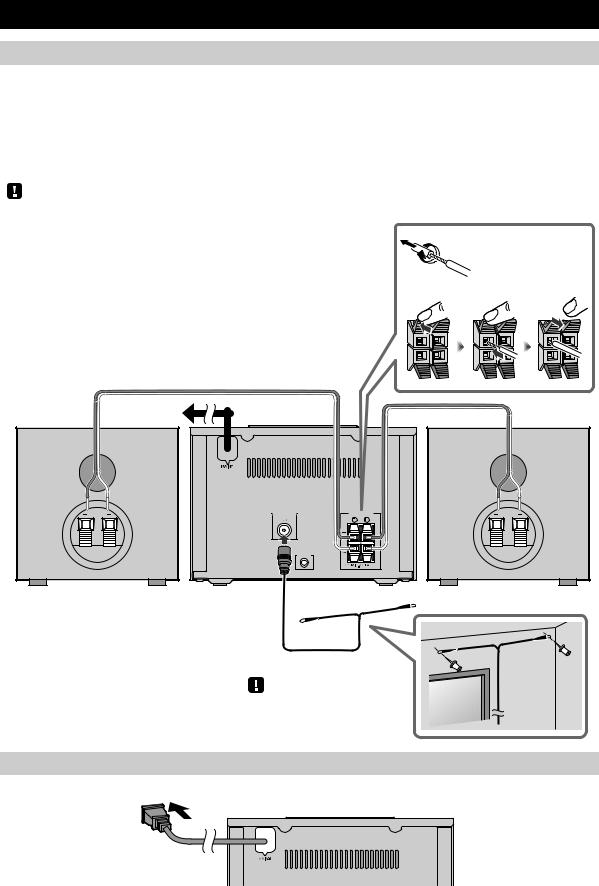
CONNEXIONS
Connexion des haut-parleurs et de l’antenne
Connectez les haut-parleurs et l’antenne.
Si, au lieu de l’antenne fournie, vous utilisez une antenne extérieure disponible dans le commerce, la réception pourrait s’avérer meilleure.
Si la réception FM laisse à désirer, changez la hauteur, l’orientation ou l’emplacement de l’antenne pour essayer d’améliorer la réception.
Ne connectez pas le cordon d’alimentation de l’appareil avant d’avoir effectué tous les branchements.
Haut-parleurs
•Veillez à retirer l’isolant recouvrant l’extrémité des câbles de haut-parleur pour découvrir le fil.
•Vérifiez les connexions; assurez-vous que les indications de canal (L, R) et de polarité (rouge : +, noir : –) sont respectées. Si les connexions ne sont pas correctes, le son sera dénaturé et il se pourrait en outre qu’il manque de graves. Il se pourrait même qu’aucun son ne soit audible en cas d’erreur de connexions.
•Veillez à ce que les portions dénudées des câbles de haut-parleur ne se touchent pas et ne soient en contact avec aucune partie métallique. Cela risquerait d’endommager cet appareil ou les haut-parleurs.
•Utilisez uniquement les haut-parleurs fournis. L’utilisation d’autres haut-parleurs risquerait de dénaturer le son.
•Si, quand vous utilisez cet appareil à proximité d’un écran CRT, vous remarquez une dégradation des couleurs ou une déformation de l’image à l’écran, éloignez les haut-parleurs du moniteur.
Vers la prise secteur murale
ANTENNA |
SPEAKERS |
FM |
|
|
AUX IN |
Torsadez correctement les fils dénudés pour bien rassembler les brins individuels.
Antenne FM
Veillez à déployer correctement l’antenne.
Connexion du cordon d’alimentation
Quand toutes les connexions sont effectuées, branchez le cordon d’alimentation de cet appareil à une prise secteur.
Panneau arrière
2 Fr

CONNEXIONS
Autres connexions
iPod
Branchez votre iPod à la station d’accueil sur le panneau supérieur de l’appareil. Pour plus de détails à propos des modèles d’iPod compatibles, veuillez consulter “CARACTÉRISTIQUES TECHNIQUES” (P. 23).
Adaptateur |
Station |
de station |
d’accueil |
d’accueil |
pour iPod |
•Assurez-vous d’utiliser un adaptateur de station d’accueil compatible avec votre iPod. Si vous n’utilisez pas l’adaptateur ou s’il n’est pas compatible, la connexion peut être instable ou insuffisante, ce qui peut endommager le connecteur. Pour en savoir plus sur l’adaptateur de station d’accueil, surfez sur le site web officiel de Apple.
•Si un iPod dans sa housse de protection est connecté en forçant, le connecteur peut être endommagé. Retirez la housse de protection avant la connexion.
•Lorsque l’iPod n’est pas utilisé, mettez le couvercle de la station d’accueil en place pour protéger le connecteur.
•Votre iPod se recharge quand il est branché à sa station d’accueil. Toutefois, si vous avez sélectionné USB comme source audio, l’iPod ne se rechargera pas.
•Vous pouvez aussi écouter de la musique avec un iPod connecté au port USB tout en le chargeant. Pour ce faire, sélectionnez USB comme source audio ( P.10).
•Vous pouvez retirer l’iPod pendant la lecture.
iPad
Branchez votre iPad au port USB du panneau avant. Pour plus de détails à propos des modèles d’iPad compatibles, veuillez consulter “CARACTÉRISTIQUES TECHNIQUES” (P. 23).
Veillez à utiliser le câble connecteur de station d’accueil/USB fourni avec votre iPad.
• Si vous avez choisi USB comme source audio et mettez le système sous tension, l’iPad connecté à l’appareil se rechargera.
• Vous pouvez débrancher l’iPad pendant la lecture.
Français
Dispositif USB
Branchez votre dispositif USB au port USB sur le panneau avant. Pour plus de détails sur les types de fichiers compatibles, lisez “REMARQUES SUR LES DISQUES ET APPAREILS USB” (P. 22).
Arrêtez la lecture avant de débrancher le dispositif USB.
Si vous avez choisi USB comme source audio et mettez le système sous tension, le dispositif USB connecté à l’appareil se rechargera.
Dispositifs externes
Branchez votre dispositif externe à la prise AUX du panneau arrière avec un câble à minifiches jack stéréo de 3,5 mm disponible dans le commerce.
Panneau arrière
AUX IN |
3 Fr
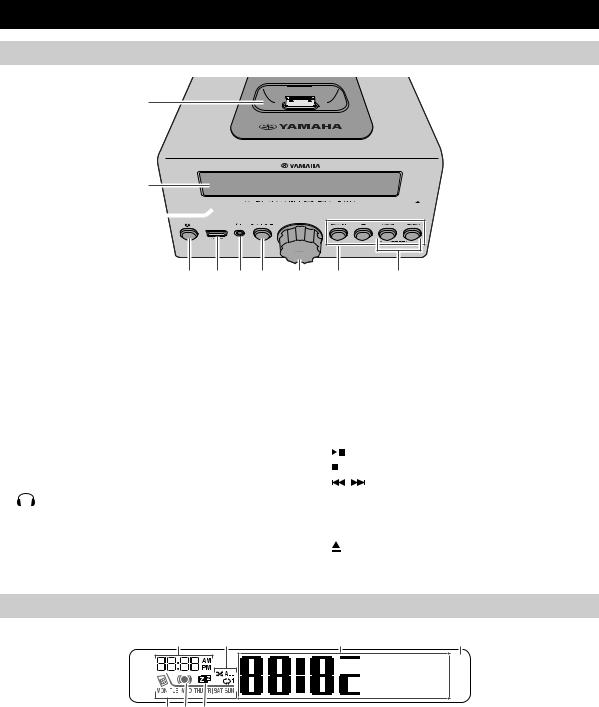
NOM ET FONCTIONS DES ÉLÉMENTS
Panneau supérieur / panneau avant
1
2
3



 k
k
4 |
5 6 7 |
8 |
9 |
j |
aStation d’accueil pour iPod
Branchez-y votre iPod ( P. 3, 6, 7).
Assurez-vous d’utiliser un adaptateur de station d’accueil compatible avec votre iPod ( P. 3).
bAfficheur
Affiche l’horloge et d’autres informations.
cFente pour disque
Insérez-y un CD ( P. 9).
d (Alimentation)
(Alimentation)
Appuyez pour allumer/éteindre le système.
ePort USB
Branchez-y votre dispositif USB / iPod / iPhone / iPad ( P. 3, 10).
f(Prise casque)
Branchez-y votre casque.
gSOURCE
Change de source audio de lecture.
Chaque pression sélectionne une source audio dans l’ordre suivant.
CD  iPod
iPod  USB
USB  FM
FM  AUX
AUX  retour à la source CD
retour à la source CD
hCommande VOLUME
Règle le volume.
iTouches de réglage audio
Commandent l’iPod/le CD/le dispositif USB.
: |
Lecture/pause |
: |
Arrêt |
/ |
: Saut, recherche arrière/avant (maintenir enfoncé) |
jPRESET  /
/ 
Ces touches permettent de choisir une station radio (présélection) que vous avez mémorisée ( P. 13).
k (Touche d’éjection)
Permet d’éjecter le CD (n’est pas disponible quand le menu Option ( P. 14) est affiché).
Afficheur
1 2
7 6 5
aHeure du réveil
Affiche l’heure du réveil programmée ( P. 18).
bIndicateur de lecture répétée/aléatoire
Affiche le mode de lecture ( P. 8, 10).
cAffichage multifonction
Affiche diverses informations telles que l’heure, des informations sur la plage en cours de lecture et la fréquence de la station radio.
dCapteur de télécommande
Veillez à ce que ce capteur soit toujours dégagé ( P. 1).
3 4









 ~ ~ ~ ~ ~ ~
~ ~ ~ ~ ~ ~ 




 ~ ~ ~ ~ ~ ~
~ ~ ~ ~ ~ ~
eIndicateur de minuterie
S’allume si la minuterie est activée ( P. 15).
fIndicateur d’alarme
S’allume si l’alarme est activée ( P. 18).
gIndicateur d’alarme hebdomadaire
Affiche les réglages d’alarme effectués avec l’application gratuite “DTA Controller” pour iPod touch/iPhone/iPad ( P. 16).
4 Fr
